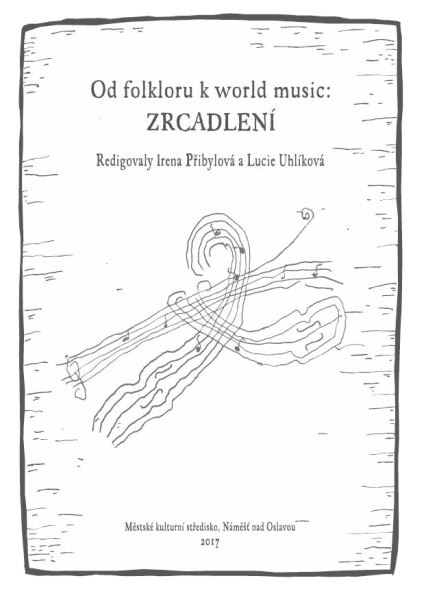Colloquy 2017

A discussion about the contemporary position of music in today’s world seems to be filled with never-ending possibilities. Reflections is the topic chosen by the organizers of the 14th specialized colloquy on folk music traditional and modern, ethnic music and world music, which took place in Náměšť nad Oslavou (CZ) 25–26 June 2017, and attracted two dozen active participants from several countries.
Music has often reflected the soul of a musician, his/her thinking, opinions, knowledge, as well as pragmatism or calculations. At the same time, music is the reflection of culture and society: traditional music of various ethnic groups emerged within a specific space and accepted canon; quite often it gradually absorbed outside influences. Music of different social levels developed in an analogous way: often in a connection with the period and artistic styles, as well as ideologies and mass culture.
Both the reflection of music and reflection within music are quite typical for today’s world and its crossings of music boundaries of genres, ethnicity, and more. An inspiration may rise out of local and foreign cultures; personal creative ability may carry or change contexts and meanings, bridge geographical and historical distances, and result in unique authorial accounts. Music may also inspire non-musical reflections, values and manifestations which are likely or even unlikely in harmony with universally proclaimed social rules. And finally, the reflections may include scholarly reflections, which do not create music, but through its cognition they help capture music phenomena over the time, which is not always favourable to activities of man.
Since its inception in 2003, the Náměšť colloquy has provided a meeting space for the representatives of two areas – an academic one, and a publicistic one. They discuss their research, discoveries, opinions, and suggestions there. In the end, such a meeting enriches not only its active participants, but the audience as well: people come to attend the colloquy from the music festival which happens simultaneously (in 2017, it was the 32nd anniversary of the festival).
The present volume of papers is quite rich in dealing with “reflections”. It includes foreign understanding and treatment of traditional Moravian folk songs (Ulehla, Moretti). Both authors develop in their distinct way environmental ideas, which are part of contemporary trends in scholarly research into folk music. Other papers show traditional music and dance within an international context (Pavlicová – Uhlíková), a multicultural context (Ulrychová), or within a distorted mirror of ideology (Zajedová). There is also a paper on a unique effort to revive the oral tradition of the Irish Middle Age (Bracken – Mac Mathúna). The spontaneous singing of school children and young ones in the digital age is observed in another paper (Toncrová). Contemporary concerns to capture the vanishing regional forms of traditional music are reflected as well (Michalovič). Two possible unions of the word and music are presented: one reflects the contemporary Czech protest song (Tesař), whereas another deals with music and fiction in English (Přibylová). The pioneer of music without words, Lord Buckley, is remembered (Dorůžka). The question of visual images of music media and the identity of the folk singer is discussed too (Sobotka). One essay offers a possible new classification of songs (Plocek). The volume reflects the international milieu of the colloquy, where English, Czech, and Slovak languages were spoken.
As in the previous years, the volume presents just a selection of what was happening at the colloquy. Some presentations would need more than just a paper version, dealing with audio and visual dimensions (such as examples of the Slovak TV folklore show; the sounds and shapes of the Beskydy mountain whistles; and the journey of the Sefardi song), and some papers would deserve a special medium (research into various forms and understanding of modern folk music in European broadcasting). The colloquies in Náměšť invite special guests to their afternoon seminars: In 2017, Casey Driessen, an American violin player, introduced and performed his pioneering theory on chopping in the bowed string instrument family.
Every year of the colloquy and the consequent volume of papers come with a special challenge. We hope that we met it successfully in 2017, and that you enjoy reading it!
.
(from introduction)
Od folkloru k world music: REFLECTIONS
- Martina Pavlicová – Lucie Uhlíková | Folklor v zrcadle individuálních a společenských zájmů (na příkladu českého etnologa Františka Pospíšila) (PDF)
- Martina Pavlicová – Lucie Uhlíková | Folklore in the Mirror of Individual and Social Interests (the Case of the Czech Ethnologist František Pospíšil) (PDF)
- Marta Ulrychová | Drham is drham neboli Doma je doma – obraz domova v tvorbě krušnohorského písničkáře Antona Günthera (PDF)
- Peter Michalovič | Ľudová hudba v meste – odraz zmien v nástrojovom zložení (so zreteľom na slovenské Záhorie) (PDF)
- Marta Toncrová | Lidová píseň a zpěv nejmladší generace (PDF)
- Iivi Zájedová | Pokřivené zrcadlo folkloru (na příkladu estonských národních tradic) (PDF)
- Jiří Plocek | Co zrcadlí písně? Pokus o změnu pohledu (PDF)
- Julia Ulehla | Aj, ty milý orle, viděls krávy moje? Reflexe moravské písně v severoamerickém domorodém prostoru (PDF)
- Julia Ulehla | And You, Dear Eagle, Have You Seen My Cows? Reflections of Moravian Song in North American Indigenous Spaces (PDF)
- Elia Moretti | Imaginary Folklore in Southeastern Moravias (PDF)
- Daire Bracken – Lorcán Mac Mathúna | Preab Meadar – krev z vyschlých kostí (PDF)
- Daire Bracken – Lorcán Mac Mathúna | Preab Meadar – The Blood of Dried Bones (PDF)
- Jan Sobotka | Před zrcadlem: zrození písničkáře jako komická overtura? (PDF)
- Petr Dorůžka | Dvě strany téže mince: zrcadlení textu do hudby a naopak (hudba beze slov, slova místo hudby) (PDF)
- Irena Přibylová | Fenomén hudby ve fikci: od country po zydeco v anglicky psané literatuře (PDF)
- Milan Tesař | Angažovaný písňový text jako zrcadlo současné rozechvělé společnosti (PDF)
- Medailony autorů (PDF)
- Notes on Contributors (PDF)
- Complete book (PDF)


